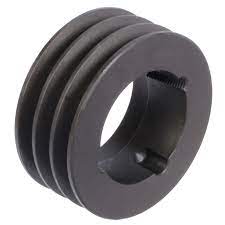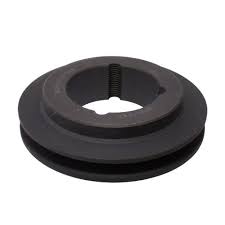Product Description
Quick Details
| Applicable Industries:
Building Material Shops, Manufacturing Plant, Machinery Repair Shops, Food & Beverage Factory, Construction works , Energy & Mining, Other |
Customized support:
OEM, ODM |
| Part name :SPA CHINAMFG cast iron pilot bore 3 grooves timing belt pulley | Surface treatment: Blackened/blue |
| Material: C45 | Brand Name:REACHJY |
| Application:power transmission | Inspection: 100% |
| Certification:ISO | Place of Origin:ZheJiang , China |
| Certification: | ISO |
|---|---|
| Pulley Sizes: | SPA Spb |
| Manufacturing Process: | Cast Iron |
| Material: | Steel |
| Surface Treatment: | Blackened/Blue |
| Application: | Chemical Industry, Grain Transport, Mining Transport, Power Plant |
| Samples: |
US$ 50/Piece
1 Piece(Min.Order) | |
|---|
| Customization: |
Available
| Customized Request |
|---|

Are there different types of spa pulleys, and how do they vary in spa applications?
Yes, there are different types of spa pulleys available, and they can vary in terms of design, materials, and specific applications within a spa system. Here’s a detailed explanation of the various types of spa pulleys and their variations in spa applications:
1. V-Belt Pulleys:
V-belt pulleys are one of the most common types of pulleys used in spa applications. They feature a V-shaped groove that matches the cross-section of V-belts, which are commonly used power transmission belts. V-belt pulleys provide reliable power transmission, high torque capacity, and are suitable for moderate to heavy-duty applications. They are often used in spa systems to transfer power from the motor to various components such as pumps, blowers, or jets.
2. Flat Belt Pulleys:
Flat belt pulleys, as the name suggests, have a flat surface for belt engagement. They are typically used with flat belts made of materials such as rubber or fabric. Flat belt pulleys are suitable for applications requiring moderate power transmission and are commonly used in spa systems for driving components like pumps or fans.
3. Timing Belt Pulleys:
Timing belt pulleys are designed to work specifically with timing belts, which have teeth on the inner surface. The teeth on the belt mesh with corresponding grooves on the pulley, enabling precise and synchronous power transmission. Timing belt pulleys are commonly used in spa applications where accurate timing and synchronization of components are required, such as in spa control systems or automated functions.
4. Idler Pulleys:
Idler pulleys are used to redirect or guide belts within a spa system. They do not transmit power but help maintain proper belt tension and alignment. Idler pulleys can be used in conjunction with other types of pulleys to ensure smooth operation and prevent belt slippage or excessive wear. They are commonly found in spa systems where multiple pulleys and belts are used, such as in complex pump or motor configurations.
5. Materials:
Spa pulleys can be made from various materials, and the choice of material depends on factors such as durability, resistance to corrosion, and compatibility with the spa environment. Common materials used for spa pulleys include stainless steel, aluminum, brass, or various types of plastics or polymers. Stainless steel and aluminum pulleys are often preferred for their corrosion resistance, while plastics or polymers may be used for their lightweight properties or chemical resistance.
6. Size and Configuration:
Spa pulleys come in different sizes and configurations to accommodate specific spa applications. The size of the pulley, including its diameter and width, is determined based on factors such as the power requirements, belt size, and desired speed ratio. Pulleys may have different numbers of grooves or teeth to match the number of belts or the desired timing of the system. The specific configuration and size of the pulleys are chosen to ensure proper power transmission, belt engagement, and compatibility with the overall spa system.
In summary, there are different types of spa pulleys, including V-belt pulleys, flat belt pulleys, timing belt pulleys, and idler pulleys. They can vary in terms of design, materials used, and specific applications within a spa system. The choice of pulley type, material, and size depends on factors such as the power requirements, belt type, desired speed ratio, and compatibility with the spa environment. Proper selection and use of spa pulleys are crucial for efficient power transmission and reliable operation of various components within the spa system.

How do spa pulleys impact the overall performance and water quality in a spa?
Spa pulleys have a significant impact on the overall performance and water quality in a spa. Here’s a detailed explanation of how spa pulleys influence these aspects:
1. Water Circulation:
Spa pulleys play a critical role in facilitating water circulation within the spa system. The pulleys are connected to the pump impeller, which generates the necessary water flow. Efficient power transmission from the motor to the pump impeller ensures adequate water circulation throughout the spa. Proper water circulation helps maintain even water temperature, ensure uniform distribution of chemicals, and prevent the formation of stagnant areas where contaminants can accumulate.
2. Jet Performance:
The performance of spa jets, which provide hydrotherapy and massaging effects, is influenced by the pulleys. By controlling the speed and torque output of the pump impeller through the pulleys, the intensity and pressure of the jets can be adjusted. Properly sized and configured pulleys enable optimal jet performance, allowing users to customize the water pressure and flow rate to their preferences. This enhances the overall spa experience and ensures the effectiveness of hydrotherapy treatments.
3. Air Delivery:
In spas equipped with air blowers or air injectors, spa pulleys also impact the delivery of air. Air blowers or injectors are often driven by the motor through pulleys and belts or cables. The pulleys control the speed and power transmission, influencing the amount and intensity of air delivered to the spa. By adjusting the pulley size or ratio, the air delivery can be modified, affecting the aeration and bubbling effects in the spa. This contributes to the overall ambiance and relaxation experience for spa users.
4. Energy Efficiency:
Well-designed and properly maintained spa pulleys contribute to energy efficiency in the spa system. Efficient power transmission from the motor to the pump or other driven components minimizes power losses, reducing energy consumption. By ensuring the pulleys are correctly sized, aligned, and tensioned, unnecessary friction and wear can be minimized, resulting in smoother operation and improved energy efficiency. This not only reduces operating costs but also supports sustainable and eco-friendly spa practices.
5. Water Filtration:
Proper water filtration is crucial for maintaining water quality in a spa, and spa pulleys indirectly impact this process. The pump, driven by the pulleys, circulates water through the filtration system, removing debris, particles, and contaminants. Effective power transmission ensures sufficient water flow through the filter, optimizing its filtration capacity. Clean and properly functioning pulleys contribute to uninterrupted water filtration, preventing clogs or reduced filtration efficiency. This helps in maintaining clear and healthy spa water.
6. Overall System Reliability:
Reliable spa pulleys are essential for the overall performance and longevity of the spa system. Well-maintained pulleys minimize the risk of belt or cable slippage, misalignment, or premature wear. This enhances the reliability and durability of the pulley system, reducing the likelihood of breakdowns or interruptions in spa operation. A reliable pulley system ensures consistent performance, allowing spa owners to enjoy their spa with confidence.
In summary, spa pulleys have a significant impact on the overall performance and water quality in a spa. They influence water circulation, jet performance, air delivery, energy efficiency, water filtration, and the overall reliability of the spa system. By ensuring proper sizing, alignment, tensioning, and maintenance of the pulleys, spa owners can optimize the performance, enhance the spa experience, and promote clean and healthy spa water.

How do spa pulleys contribute to the operation of water circulation and jets?
Spa pulleys play a crucial role in the operation of water circulation and jets within a spa or hot tub system. Here’s a detailed explanation of how spa pulleys contribute to the operation of water circulation and jets:
1. Water Circulation:
In spa and hot tub systems, water circulation is essential for maintaining water quality, distributing heat evenly, and ensuring effective filtration. Spa pulleys are commonly used to connect the motor or drive source to the pump impeller. As the motor rotates, it drives the spa pulley, which then transfers rotational power to the pump impeller. The impeller creates a suction force that draws water into the pump and then pushes it through the filtration system and jets, facilitating water circulation throughout the spa or hot tub.
2. Jet Operation:
Jets in a spa or hot tub system are responsible for creating therapeutic water flow and pressure. Spa pulleys play a significant role in powering and controlling the jets. The motor or drive source is connected to the pump impeller via the spa pulley. As the impeller spins, it pressurizes the water, which is then directed through the jet nozzles. The spa pulley ensures that the impeller receives sufficient rotational power to generate the desired water flow and pressure, providing a soothing and invigorating hydrotherapy experience.
By transferring rotational power from the motor to the pump impeller, spa pulleys enable efficient water circulation and jet operation in the following ways:
Belt Engagement: The grooved or toothed surface of the spa pulley securely engages the belt, such as a V-belt or timing belt, preventing slippage. This ensures that the rotational power from the motor is effectively transferred to the pump impeller, promoting consistent water circulation and jet performance.
Power Transmission: The spa pulley acts as a mechanical link between the motor or drive source and the pump impeller. As the motor rotates, the pulley rotates as well, transmitting rotational power to the impeller. This power transmission drives the impeller’s spinning motion, creating the necessary water flow and pressure for water circulation and jet operation.
Pulley Ratio: In some cases, spa pulleys are designed with specific ratios to achieve desired speed or torque outputs. By selecting pulleys with the appropriate ratio, the rotational speed or torque can be adjusted to meet specific water circulation and jet performance requirements. This allows for customization and optimization of the system’s water movement and therapeutic effects.
Overall, spa pulleys are integral components that contribute to the smooth operation of water circulation and jets in spa and hot tub systems. They ensure the efficient transfer of rotational power from the motor to the pump impeller, facilitating proper water flow, pressure, and distribution throughout the system, as well as delivering an enjoyable hydrotherapy experience.


editor by CX
2023-12-11